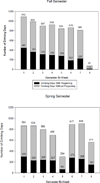Predictors and consequences of pregaming using day- and week-level measurements
- PMID: 23438241
- PMCID: PMC3966428
- DOI: 10.1037/a0031402
Predictors and consequences of pregaming using day- and week-level measurements
Abstract
Drinking before going to a social event is common in adolescents and young adults and is associated with harmful outcomes, but information collected at the daily level is needed to better examine individual and contextual factors associated with pregaming. The purpose of this study was to investigate the prevalence of pregaming in a diverse sample of college students; demographic differences in rates of pregaming; the degree to which pregaming is associated with higher volume drinking, intoxication, and consequences; and the importance of time-of-year and day-of-week. College students (N = 750) at three colleges completed past-week surveys throughout their freshman and sophomore years. Pregaming was reported by 3 out of 4 drinkers and occurred on 31% of 12,361 drinking days. Compared with nonpregaming days, participants drank approximately 2 more drinks on pregaming days; this increase accounted for a .040 higher estimated blood alcohol concentration. Using generalized estimating equations, we established that women, racial/ethnic minority students, and first-year students were more likely to pregame on a drinking day than males, non-Hispanic White students, and sophomore students, respectively. Men became more intoxicated on pregaming days and sophomores consumed more alcohol. Pregaming predicted higher positive and higher negative consequences, even after controlling for the number of drinks consumed. Pregaming was more common in the fall semester, in the early weeks of each semester, and on weekends. Prevention efforts targeting first-year students, the early weeks of the semester, and the hours before traditional party times may be effective at reducing this hazardous practice.
PsycINFO Database Record (c) 2013 APA, all rights reserved.
Figures

References
-
- Baer JS, Kivlahan DR, Marlatt GA. High-risk drinking across the transition from high school to college. Alcoholism: Clinical and Experimental Research. 1995;19(54–61) - PubMed
-
- Beets MW, Flay BR, Vuchinich S, Li KK, Acock A, Snyder FJ. Longitudinal patterns of binge drinking among first year college students with a history of tobacco use. Drug and Alcohol Dependence. 2009;103(1–2):1–8. - PubMed
-
- Carey KB, Hustad JT. Are retrospectively reconstructed blood alcohol concentrations accurate? Preliminary results from a field study. Journal of Studies on Alcohol. 2002;63(6):762–766. - PubMed
Publication types
MeSH terms
Grants and funding
LinkOut - more resources
Full Text Sources
Other Literature Sources
Medical
Miscellaneous

